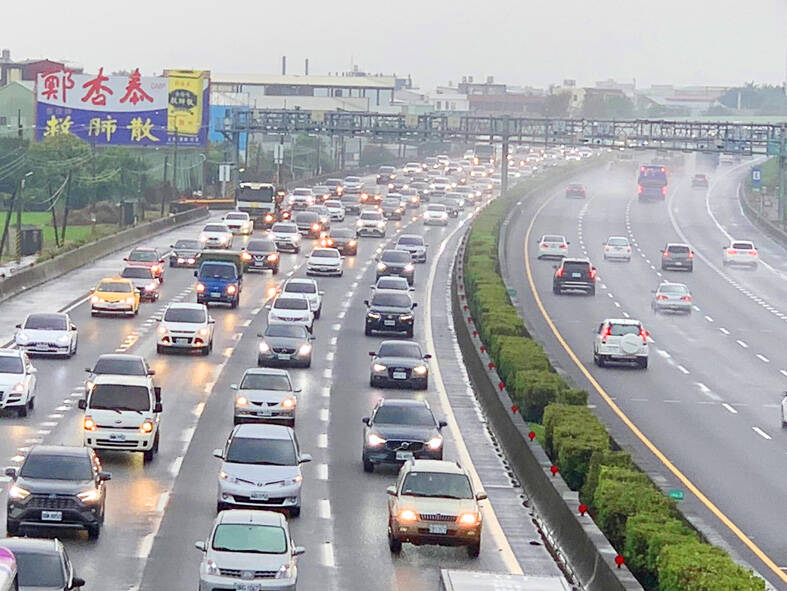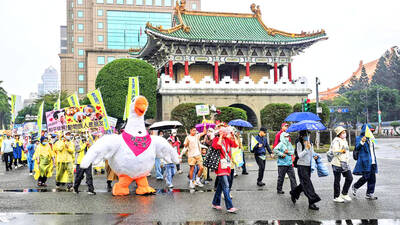The Taiwan Transportation Safety Board yesterday pledged to work with the Ministry of Transportation and Communications to review laws in other countries governing the regulation of self-driving vehicles following a rise in collisions caused by the vehicles, the board’s acting chairwoman Iris Hsu (許悅玲) said at a meeting of the legislature’s Transportation Committee.
Democratic Progressive Party (DPP) Legislator Hsu Chih-chieh (許智傑) said that 36 incidents of self-driving automobiles colliding with construction vehicles on freeways were recorded in 2021.
Last year, four people died in collisions caused by self-driving vehicles, he said.

Photo: Tang Shih-ming, Taipei Times
Over the past two years, 87 percent of collisions with freeway construction vehicles were caused by vehicles equipped with an advanced driver assistance system, he added.
Although the number of self-driving vehicles in the nation has been rising, laws to regulate them have yet to be drafted, Hsu Chih-chieh said.
“The US, Japan and Germany have already put relevant regulations in place. Taiwan only has the Unmanned Vehicles Technology Innovative Experimentation Act (無人載具科技創新實驗條例),” he said.
“Should we not identify laws that should be in place and establish a mechanism to investigate incidents caused by self-driving vehicles or autonomous buses?” he asked.
The safety board has experts to study self-driving vehicles and should bear some responsibility to regulate them, he added.
The transportation ministry, rather than the safety board, is in charge of regulating self-driving vehicles, Iris Hsu said.
“We have exchanged views on issues related to self-driving vehicles with academic experts. As an independent investigative agency, we cannot be players and referees at the same time… We can work with the ministry to review regulations in other countries,” she said.
Safety board employees appear to spend more time engaging in personal conflicts instead of investigating transportation incidents, DPP Legislator Lin Chun-hsien (林俊憲) said.
Although the board last year investigated nearly 60 marine incidents, it only investigated four aviation incidents, seven railway incidents and three highway incidents, Lin said.
“Despite more people using the highway system than marine transportation, the board investigated so few highway incidents last year because the criteria to launch investigations has been set too high,” he said.
“A highway incident must result in at least three deaths, at least 10 deaths and injuries, or at least 15 injuries to warrant an investigation,” he said.
The US National Transportation Safety Board investigates incidents if they pose “potential systemic risks,” he said.
“We do not see the board publish similar reports. Instead, we are seeing board employees engaging in internal fights by reporting each other’s wrongdoings, which is a waste of taxpayers’ money. The board is allocated a budget of about NT$200 million [US$6.5 million] per year,” he said.
“The agency’s budget plan for the next fiscal year should be subject to stricter scrutiny,” he added.
Lin also criticized the board for being slow to build capacity for investigating incidents caused by self-driving vehicles. As of March 28, 29 freeway construction vehicle collision accidents had been reported, with most of them caused by vehicles equipped with advanced driver assistance systems, he said.
Former safety board chairman Young Hong-tsu (楊宏智) in February resigned following allegations that he visited family members and conducted other private affairs during work hours.

NUMBERS IMBALANCE: More than 4 million Taiwanese have visited China this year, while only about half a million Chinese have visited here Beijing has yet to respond to Taiwan’s requests for negotiation over matters related to the recovery of cross-strait tourism, the Tourism Administration said yesterday. Taiwan’s tourism authority issued the statement after Chinese-language daily the China Times reported yesterday that the government’s policy of banning group tours to China does not stop Taiwanese from visiting the country. As of October, more than 4.2 million had traveled to China this year, exceeding last year. Beijing estimated the number of Taiwanese tourists in China could reach 4.5 million this year. By contrast, only 500,000 Chinese tourists are expected in Taiwan, the report said. The report

Temperatures are forecast to drop steadily as a continental cold air mass moves across Taiwan, with some areas also likely to see heavy rainfall, the Central Weather Administration (CWA) said. From today through early tomorrow, a cold air mass would keep temperatures low across central and northern Taiwan, and the eastern half of Taiwan proper, with isolated brief showers forecast along Keelung’s north coast, Taipei and New Taipei City’s mountainous areas and eastern Taiwan, it said. Lows of 11°C to 15°C are forecast in central and northern Taiwan, Yilan County, and the outlying Kinmen and Lienchiang (Matsu) counties, and 14°C to 17°C

STEERING FAILURE: The first boat of its class is experiencing teething issues as it readies for acceptance by the navy, according to a recent story about rudder failure The Hai Kun (海鯤), the nation’s first locally built submarine, allegedly suffered a total failure of stern hydraulic systems during the second round of sea acceptance trials on June 26, and sailors were forced to manually operate the X-rudder to turn the submarine and return to port, news Web site Mirror Daily reported yesterday. The report said that tugboats following the Hai Kun assisted the submarine in avoiding collisions with other ships due to the X-rudder malfunctioning. At the time of the report, the submarine had completed its trials and was scheduled to begin diving and surfacing tests in shallow areas. The X-rudder,

DEMAND: The government should enact regulations in line with Austria and Germany to incorporate vegan nutrition into school meals, an advocate said More than 1,000 people yesterday marched in Taipei to promote veganism, calling for legislation to incorporate vegan diets into school lunches and the national net zero emissions program. Participants gathered on Ketagalan Boulevard in front of the Presidential Office Building for the march, which was organized by the Vegan Action Network (VAN). Former ambassador to Chad Chiu Chung-jen (邱仲仁), actor Yankee Yang (楊子儀) and actress Cindy Lien (連俞涵) attended the event. VAN member Marianne Chao (趙梅君) said that the campaign aimed to urge the government to promote vegan diets across schools and government agencies via legislation and national policies, which would help build